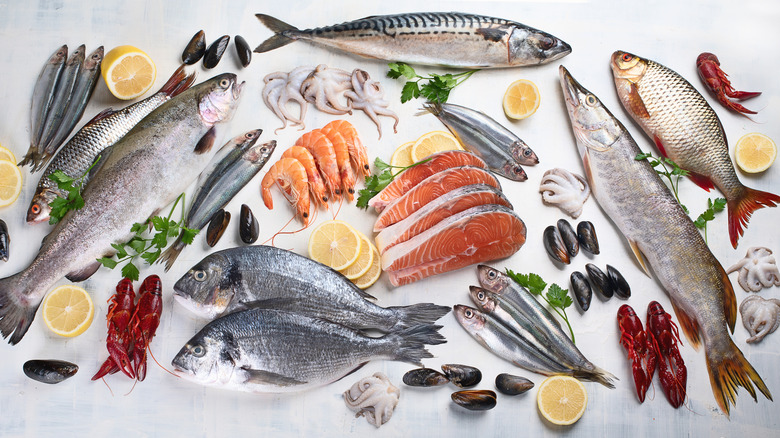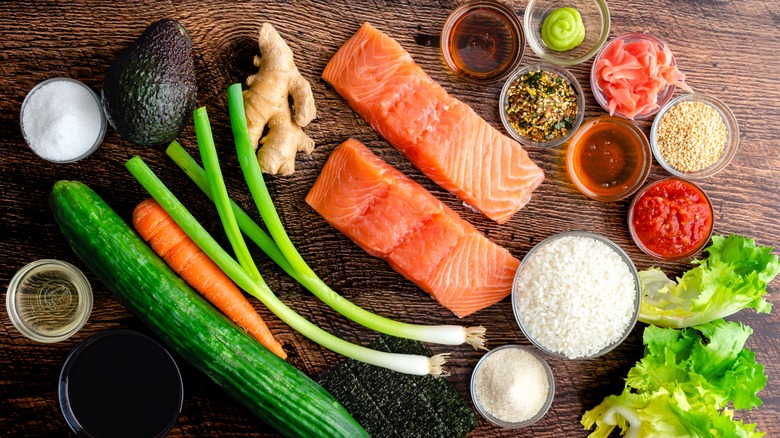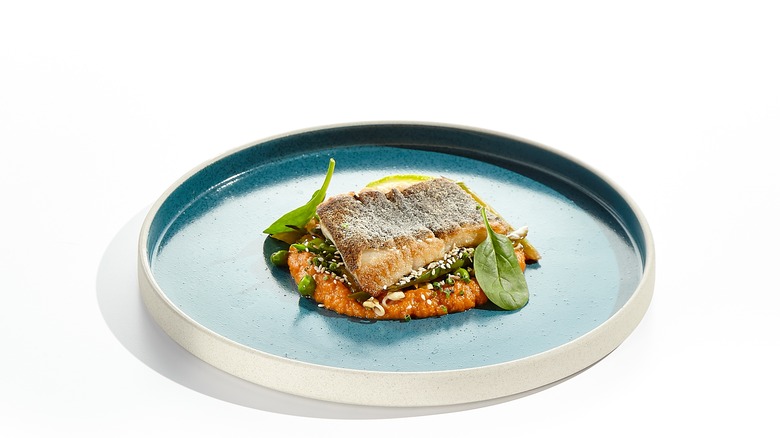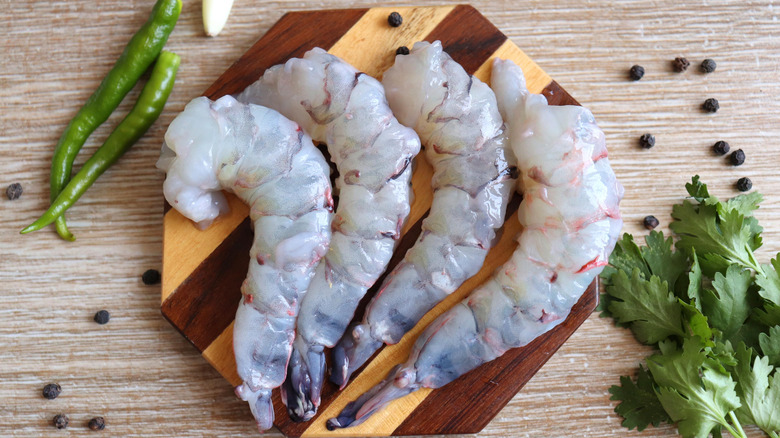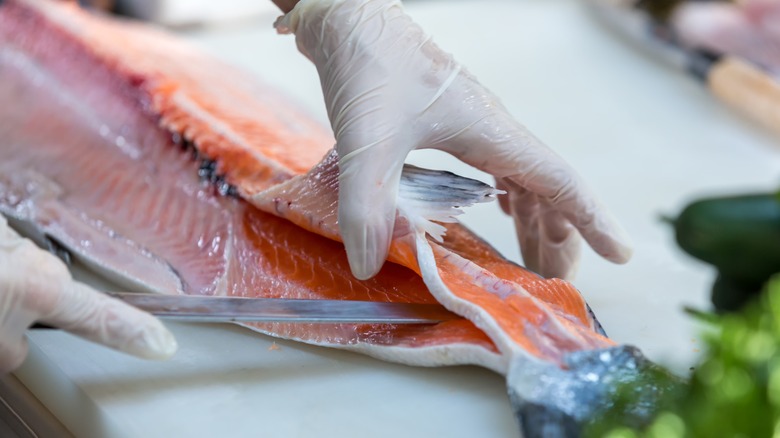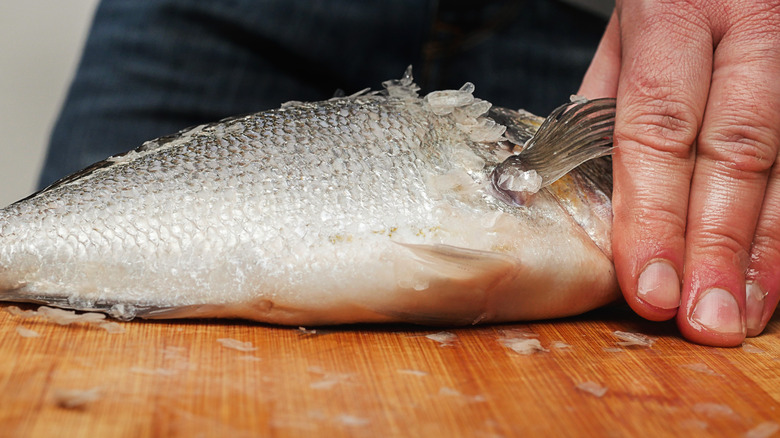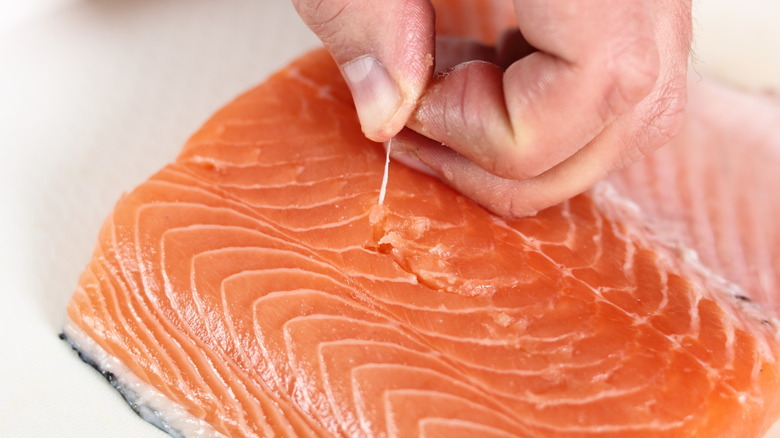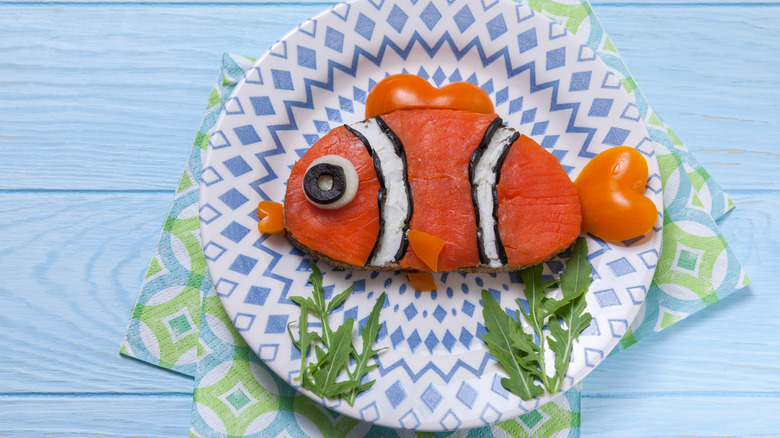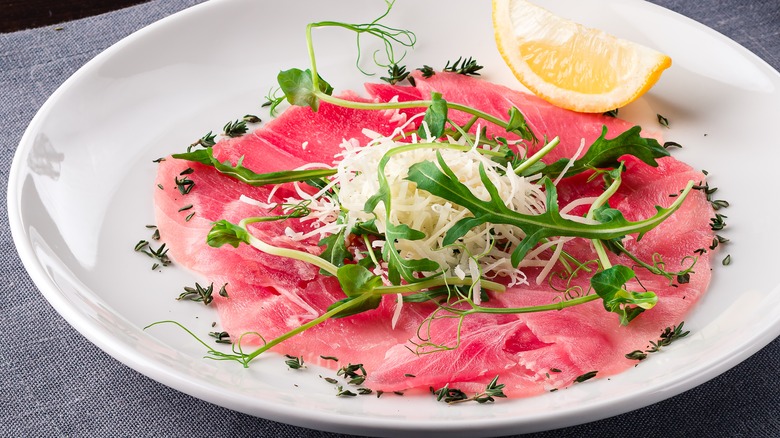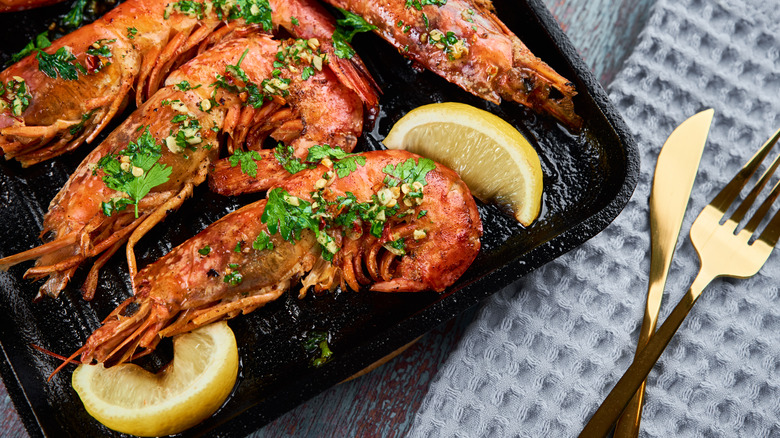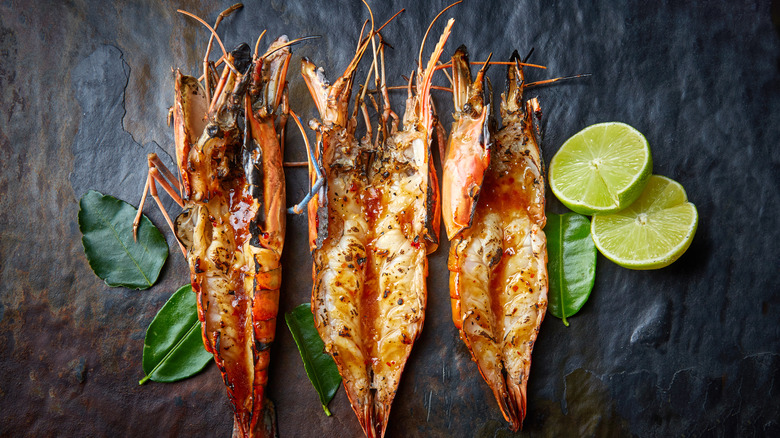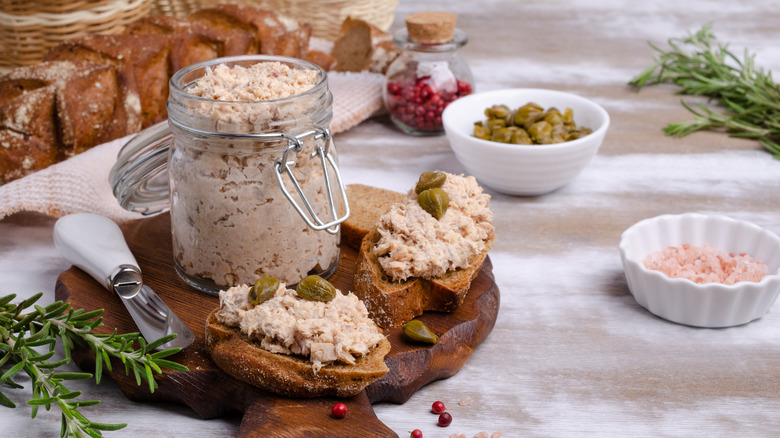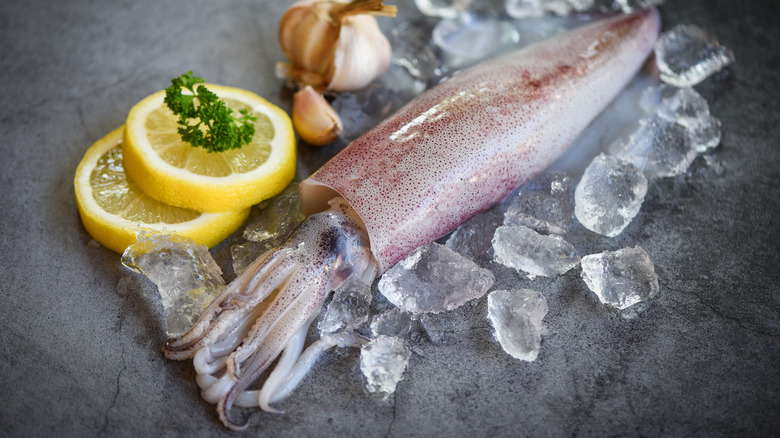Hacks For Cooking Fresh Fish You'll Wish You Knew Sooner
Cooking with fresh fish can be a bit daunting, especially if you're used to heading to the freezer or throwing a few fish sticks in the oven. However, if you buy your fish already boned and gutted, or if you're ready to cook it as a fillet, then you really just need some good, everyday fish recipes and some fintastic tips. From learning how to check the bones are out of your fish, to baking salmon in the shape of a braid, to knowing what to do with leftovers, there are hacks for every fresh fish occasion. If you think about it, there are plenty of choices when it comes to seafood, from shrimp to lobster, cod, tuna, and squid. You only need a few added ingredients to make a stunning fish dish that's quick to make, too.
And don't forget, fish is good for you. It's full of vitamins and minerals, as well as omega-3 fatty acids. It's a powerful source of protein, while also generally being lower in fat than red meats. Halibut, for example, is rich in potassium, while sardines have lots of iron, calcium, and selenium (via Medical News Today). Learning about the taste and characteristics of different types of seafood can really open up your culinary experience, as can experimenting with different ways of cooking fish. You may wish that you'd known these hacks sooner — why not try some of them out?
Freshen fish fillets
Even if you're a seafood fan, the thought of cooking fish at home can sometimes not appeal simply because of the odor. If other people are around who aren't quite so keen on fish as well, then that's really going to put you off. The issue is that sometimes the strong smell comes from fish that isn't quite as fresh as it could be. It's not necessarily that your fillet isn't good enough to eat, it's simply that it's not so fresh as a catch straight off the boat. You'll be pleased to know that there's a great little trick for mellowing out the odor, so check out a fabulous fish recipe, such as baked mahi mahi.
Get your fish fillet and soak it in milk. Wait 20 minutes before drying off and cooking your fish as you like. The protein in the milk offsets the stink that's caused by a chemical reaction, so your fish looks, smells, and tastes fresher (via How To). First For Women put the milky fish bath hack to the test with a piece of salmon and reported a less fishy aroma emanating from the milk-soaked fillet while it was cooking. Posting on TikTok, @marycordovanjuguna soaks her fish in milk in a Ziploc bag.
Make a salmon rice bowl with an ice cube
Sometimes a TikTok culinary hack really cooks up a storm online, and there's no doubt that this Asian-inspired rice bowl made with cooked salmon is one of those. Posted by @emilymariko, there's a great reheating rice trick in the recipe, too. Flake a cooked salmon fillet and mix it with some cooked rice in a bowl. Next, you're going to use an ice cube hack by adding a cube or two to the top of the rice and salmon. Cover with greaseproof paper and heat in the microwave. The ice cube makes sure the rice heats up and is nice and fluffy, instead of dry. You can discard it after warming.
Pour a little soy sauce and Sriracha onto the rice and fish, and squirt on some Kewpie-style mayonnaise. Mix together, then split an avocado, and slice half of it into a fan, adding it to the top of your bowl. In a separate, smaller bowl, add some kimchi, and for some crunch, top your salmon bowl with a packet of crispy seaweed snacks. Place a piece of the avocado and seaweed over the salmon rice with your chopsticks, and enjoy.
Crisp up fish skin snacks
Do you throw fish skin away once it's cooked and you've eaten all the succulent fillet? Or maybe you remove the skin before cooking fish? In any case, you're missing out on a delicious culinary tip that turns fish skin into a scrumptious fried snack. One that you can enjoy with or without fish, as it's delicious just as it is. Why not give it a go, as @antoniskourkoutas does with a TikTok post?
Boil a raw fish skin for less than 30 seconds and remove any fish that's stuck to it with a knife. It's important that the skin dries completely, so do this at a temperature of 140 F. Heat your deep fryer up to 375 F and add your dry, clean fish skin. Within seconds it should take on a bubbling appearance. Take it out, let the oil drain, and sprinkle salt and spices over the top if you want extra flavor. You can now break the fish skin into pieces and these crunchy bites are ready to enjoy.
Devein shrimp
While the brown line that goes along the back of a shrimp is called a vein, it's actually the digestive tract. While you're not likely to get ill if you eat the veins, they're not exactly appetizing in taste or thought (via Nature Noon). If you're taking the time to cook a wonderful shrimp dish, such as Puerto Rican colossal shrimp mofongo, then you probably want to make the effort to devein your shrimp. If you want to cook shell-on shrimp – if you're grilling them, for example — then you'll need a hack for deveining without peeling. It's easy when you know how (via @cris.ibanez). Pubs with Chopsticks recommends putting the stick into the shrimp where the tail meets the shell segment.
Take a toothpick and pierce a shrimp about halfway between the head and the tail so it goes between the sections of the shell, and not too far from the surface, but beneath the vein. Once through, pull the toothpick upward, so it pushes up through the shell section on the ridge of your shrimp and brings the vein with it. Use your fingers to gently pull on this black line until it's all been removed in one piece. Meanwhile, if you want to devein and peel at the same time, then cut along the shrimp to the tail along the shell using scissors deep enough to remove the vein, and the shell can be peeled off (via @myhealthydish).
Braid a salmon fillet
Bring a little style to fish cooking with TikTok's braided salmon fillet trend. Not only is this salmon idea easy, it looks amazing. If you're adding a marinade, then it's going to get to different parts of the fish than a simpler style of fillet. You can also do this and add crab and shrimp, as per a TikTok recipe posted by @porschapower. Take the skin off a large salmon fillet and cut lengthways into three pieces, leaving the first couple of inches of the fish intact so the braids are joined at the end. Start to braid and tuck the end under and push on the sides so the fillet keeps its braided shape. Place on a bed of lemons, then season with onion powder, Old Bay, and smoked paprika.
Make a lump crab cake mixture and add this to the top of your salmon braid, and then lay jumbo shrimp across the top, seasoning with Old Bay and butter. Bake in the oven for a tasty fish trio.
@maxthemeatguy braids four strands of salmon fillet to make the fish look like challah. To do this, use brined salmon and, once it's ready to cook, add a zero-salt rub. Cook it on a hot grill outdoors with some applewood chips. Make a glaze of freshly squeezed orange juice and maple syrup, and add the glaze while the salmon is on the grill. Enjoy a slice of your salmon on a slice of braided bread.
Check that the fish is descaled
A fishmonger can descale fresh fish for you, whether you're cooking it whole, such as a grilled tilapia or a filet for baked halibut. Or, if you buy your fresh fish already packaged, then it most likely will have had the scales removed. However, before you start making a fish dish, you'll want to double-check that all the scales are off; they're not very pleasant to eat, especially if you're expecting a mouthful of soft, succulent fish. All you need is a quick hack so that if you've checked your fish and it's not totally descaled, you're able to remove any scales that remain. TikToker @kellyscleankitchen has a good tip.
You don't need any special equipment for this descaling hack, and it's so simple that it's bound to become a go-to check with any fish you're preparing in the future. Lay your fish down and run the edge of a spoon along the fish skin. Make sure that you're going against the direction of the scales; the inside of the spoon should be pointing toward the head and moving along from the tail. The scales should just flake off.
Make sure all the pinbones are out
While you might be used to buying fish that's already deboned, sometimes a few little bones remain embedded in the fillet. When you can't see the ends of these pinbones sticking out, the best way to check for them is to put your piece of fish skin-side down and run your finger along the raw fish. In the middle of the fillet, where the meat is a bit chunkier, is where you're most likely to find them. If you don't have special fish tweezers to get them out, you could try eyebrow tweezers instead — as long as the edge is flat. Real Simple offers a neat pinbone tip to make this fiddly job a bit easier, and all you need is a small mixing bowl.
Place the bowl upside down on your counter. Drape your fish fillet over the top, with the skin down. The curve will help reveal any pinbones more easily, and the angle should push them out enough to make their removal less arduous as well. It's a good idea to have a small dish of water at the side so you can dip your tweezers in and discard the pinbones — so they don't end up back on the fish again.
Get kids to eat more fish
Since fish is so good for you, it's worthwhile to have a trick or two to get kids — who might turn up their noses at it — to eat more. After all, many children just aren't eating the one or two weekly portions recommended (via The Bump). If you're worried about feeding youngsters fish, make appropriately small portions, and serve fish that's low in mercury. Examples include salmon and tilapia (via the Academy of Nutrition and Dietetics). All you need now is a little bit of culinary creativity at your fingertips.
Chef Jamie Oliver suggests making sure fish is part of the family menu plan, and trying out different recipes. Try adding some fish to other favorite dishes such as some flakes of salmon in macaroni and cheese. Make fish kebabs, because most little ones like skewers of food, or give them chunks of fish and other ingredients to construct their own meal. Nutrition and kids' cookbook author Annabel Karmel suggests giving kids fish along with a variety of colorful vegetables and asking them to make their own artistically designed plate of food.
Cut tuna carpaccio the easy way
Celebrity chef Gordon Ramsay has good cooking tips for fish, such as adding a pinch of curry powder to elevate the batter when you're making fish and chips. And while having a great tip to fry, grill, or bake a fish fillet on a weeknight may make life easier, a good fish trick when you're making a dish for a dinner party can be invaluable. If you want to serve up a tuna carpaccio, for example, then as with any type of carpaccio — which is traditionally made using beef — the trick is to make sure each slice is super thin. Of course, you undoubtedly need a really sharp knife, or you'll be left hacking at the fish instead of slicing it.
Tasting Table highlights Gordon Ramsay's tip for perfectly sliced tuna carpaccio, and it's a simple yet effective one. Whether you're serving this as an appetizer or an entrée, you're going to want raw tuna and a punchy dipping sauce. You first of all need to make sure your tuna is high-quality, and that means that it's sushi-grade and can be safely eaten raw. Pop your tuna into the freezer. When it's solid, the fish will be easier to slice — as long as your knife is sharp and serrated, that is.
Grill fish with lemons
While many cookouts are meaty extravaganzas with big steaks, burgers, and sausages, seafood is also terrifically tasty when it's cooked on the grill. Cooking a piece of fish or a whole fish on the barbecue can give it a wonderfully smoky aroma and succulent taste. There's only one problem, and that's trying to cook fish this way without it sticking to the hot grill and breaking up as you try to pry it off with a spatula. All you need is to dig into some tried and tested lemon hacks and you'll find that the solution is so simple it's genius! Don't forget your can clean your hands and kitchen utensils with lemon after cooking fish.
Put lemon slices down on the hot grill, close enough together that you can lay your fish on them without touching the grate. This adds a citrusy barrier so your fish won't get stuck, and you'll get some extra flavor in there as well. Just make sure the slices are evenly cut and spaced. A TikTok post from @creative_explained also mentions that by cooking this way, you're able to flip your fish easily to cook it on both sides.
Cook langoustines on the grill
Langoustines are so darned delicious cooked any way, but they're really amazing when they're cooked on a grill. In general, fish that's barbecued is tasty, and it's super fast to cook it this way. Monkfish is also perfect for grilling, as is any kind of seafood in shells that will pop open when it's ready to eat. In an interview with the Irish Examiner, Irish chef and fish restaurant owner Aishling Moore offers some superb tips to inspire you to add fish to the menu next time you're grilling outdoors, including how best to grill langoustines.
The trick is to cut the langoustines down the middle lengthwise. That way you can see the seafood inside, but it's still wrapped up in a shell. Grill with the shells down on the grate so that the langoustine cooks within. The shell acts as a dish that heats up to cook the fish evenly. When it loses that translucent appearance and is milky white, you'll be able to see that it's cooked; remove it from the grill and add a dressing. Fresh yet strong flavors work well here, such as garlic, ginger, and lime, with chili and some fresh coriander and mint.
Create a rillette from leftover fish
While tips and tricks about the best way to cook fish are certainly useful, it's always a good idea to have a hack that guides you on what to do with leftovers. If you know that some cooked fish is going to languish in the fridge until it's thrown out, then think about how you could use it to create an appealing new dish instead. There's the satisfaction of not wasting any food ahead of you. One recipe you might not have thought of is a rillette (via Food Print).
Of course, you can leave cooked fish in the fridge for a few days, or you can freeze it for longer. Another idea is to make a spread and turn the leftovers from a fish entrée into a snack, appetizer, or buffet table sharing dish that's full of flavor. It's ridiculously easy to make. Start by flaking your fish and then blending it with cream cheese. You'll find this is easier to do if the cream cheese isn't too cold, so take it out of the fridge to soften before you mix in the fish. How thick you want your fish spread is up to you. Use yogurt or sour cream to lighten up the consistency. If you want to add some more flavor, then think about what goes well with fish, such as capers and lemon zest. Spread on crackers and serve.
Tenderize squid and cook it high or low
When it's cooked just right, squid is velvety soft with some bite — and some crunch, if you make fried calamari. However, most squid lovers have experienced rubbery rings that are tough and tasteless. That's because the squid has not been cooked in the right way, whether it's overdone, the wrong temperature has been set, or both. If the thought of cooking squid scares you, then face your fear with a couple of good tips. You need to start by cleaning squid properly and taking out the tentacles and removing any part that looks a little like a plastic quill. You can either slowly simmer squid on low heat or cook it quickly by sautéeing it in a pan (via Great British Chefs).
In ABC Everyday, chef Julie Ray suggests tenderizing the squid before cooking, either by soaking it in milk in the fridge overnight or giving it 30 minutes in lemon juice. And to really let the flavor in, score the squid in a grid design. Also in ABC Everyday, chef James Maffescioni advises that after marinating the squid, you must dry it with a kitchen towel and make sure it's not too cold — otherwise, it'll turn into a rubbery, steamed dish.
